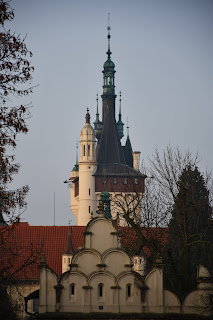Leaving Shangri-La
It was sunny on my last morning in Shangri-La. After writing
half of my homework and checking out, I strolled through the old town, stopping
again at Turtle Hill and continuing to the south of the city, which I had not
yet visited. Though the maps say the old town continues for quite a while
southwards, the pedestrian zone ended about twice as fast as it should have,
and I wound up outside the old city again. With my itinerary for my trip more
or less fulfilled, I decided to carry on south, since I remembered that at the
southernmost end of the area was an enormous white stupa. I had seen it both on
my trip from the airport and during my walk from Napa Lake.
Again, the road was lined with imposing, Soviet-looking
buildings, trees planted with perfect regularity, and even more perfectly
regular lamp posts. It was a while before I got to the stupa, but it was worth
it. When my driver on Friday said this was a new stupa and it had an older
stupa inside it, I did not quite know how to imagine the interior. As I found
out, the stupa is entirely hollow, with painted walls and a regular-size stupa
at its centre.
The Soviet administrative buildings of Shangri-la
The giant stupa of Shangri-la
Creeping rain clouds
Prayer wheels at the stupa
As was the case in Napa Lake, there were no taxis, only
organized tour busses, so I went to the airport on foot, passing by some pigs,
cows, and dogs.
Shangri-la's mountains
Roadside pigs
Shangrila's Tibetan-style airport
The last thing I did in Shangri-La was I ordered myself a
glass of yak butter tea, since I completely forgot to fulfill that obligatory touristy task while in the
city. I can’t say it was particularly remarkable, perhaps because I ordered the
sweet variety, which just tasted like watered down milk with a hint of tea.
On that
note, though, I did have a quite interesting culinary experience of Shangri-La.
Greater Tibet stands at a crossroads of civilisations, which is perhaps most
evident in its cuisine. For my first dinner in Shangri-La, I ordered vegetable
dumplings, called ‘momo,’ which – far from resembling Chinese jiaozi – struck
me as more similar in shape and flavour to Central Asian dumplings. The next
day, my lunch consisted of noodles, and I had curry for dinner, both much heavier,
a little saltier, and more reliant on onions than their respective versions in
China and India.










Comments
Post a Comment